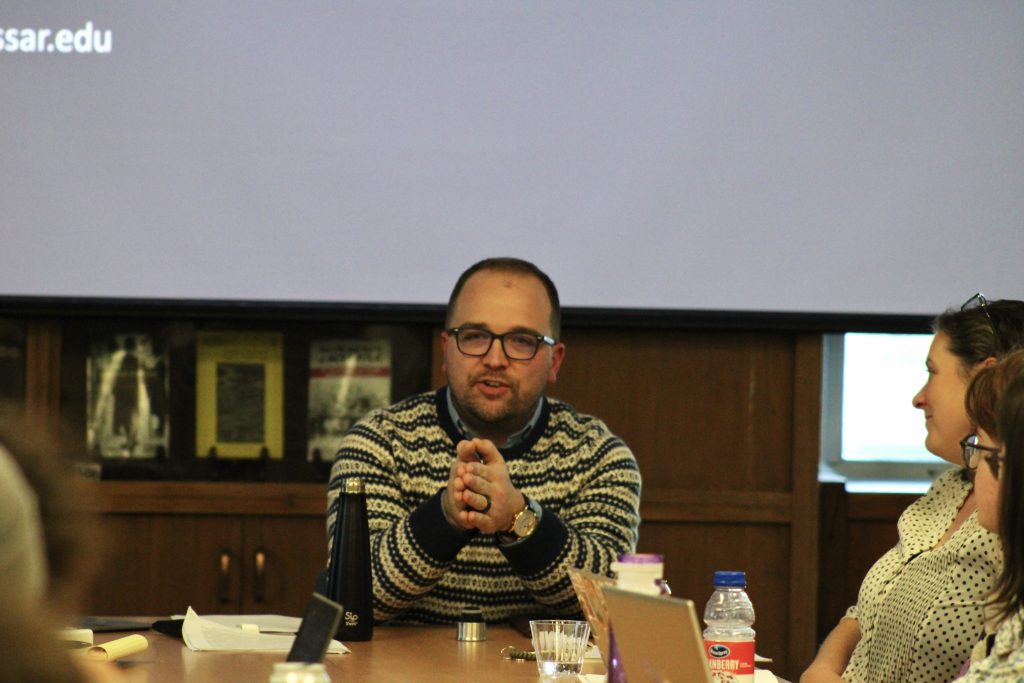The Center for Medieval and Renaissance Studies held the last installment of its public lecture series this past Wednesday in the Institute for Advanced Studies in the Humanities Conference Room.
Titled “Roman Religion and the Citizens of Empire, 200-450 CE,” the lecture was delivered by Carl Rice, a visiting assistant professor of Greek and Roman studies at Vassar College, whose research related to his dissertation. The fall lecture series is linked to the graduate seminar “Religion in Late Antiquity,” taught by Nathanael Andrade, the chair of Binghamton University’s history department.
Elizabeth Casteen, an associate professor of history and the director of CEMERS, explained the goal of the center’s lectures.
“We have been hosting conferences and speakers series essentially since the Center’s founding,” Casteen wrote in an email. “The goal has always been to highlight interdisciplinary research into the premodern world, with a particular emphasis on the Middle Ages and Renaissance. For a long time now, we have run two Speakers Series per year — one each semester. One is always tied to MDVL 501, an interdisciplinary graduate seminar that highlights new research and methodological and theoretical questions being debated by scholars.”
Rice, a former student of Andrade, earned his Ph.D. in classics and history and teaches courses on Roman history and society. His research primarily focuses on late Roman culture, and his upcoming book explores normative religious identities in the late Roman Empire.
“When I just started teaching, he was an undergraduate, but he’s gone on since then to Yale University, where he recently got his degree, and he’s written a fascinating dissertation which is gonna make an excellent book,” Andrade said. “When we’re organizing this series, we’re trying to bring in scholars from different phases of their careers — some are very, very well established, some are up-and-coming rising stars, and I think of him as a rising star.”
The lecture was divided into three parts focusing on late Roman law and religion — religious ideals and enslavement, religion and enslaved property, and religion and legal action. Rice also strived to answer two key questions within his three-part talk — “Why did late Roman rulers become so interested in legislating religious identity from the third century onward?” and “What motivated emperors to legislate religion the ways that they did?”
“For much of their history, the Romans didn’t care much about religious difference, at least not from a legal point of view,” Rice explained in his lecture’s introduction, focusing on the Roman Empire before its increased religious persecution. “With only a few brief exceptions, Roman lawmakers of the so-called classical period did not actively legislate matters of religion. So long as individuals were present at collective civic rituals, participated as was appropriate to their station, showed the obeisance to imperial rulers, paid their taxes and didn’t cause any trouble, the Romans largely left what we might today call minority religious communities alone.”
The first part of Rice’s talk on the late Roman Empire focused on enslavement caused by religious identity. He explained how a person’s religious identity came to determine their societal status, like Christians from imperial households being enslaved. However, there were also laws put in place that could free a slave if they were forced to follow their enslavers’ religious practices. Rice concluded this section by stating that Roman law created pathways to enslavement or freedom based on someone’s religious identity.
He continued by highlighting the different ways Romans could lose property based on their religion, explaining how this was a result of Roman imperial leaders wanting to enforce religious norms and require conformity to them.
The third part of the lecture focused on religion and being able to take legal action. Rice explained how Christians were often unable to take legal action against others due to their religion and how, at one point in late Roman antiquity, litigants were required to perform a sacrifice to engage in legal proceedings, which prevented many from taking part. Rice emphasized this aspect of the lecture by showing a picture of a papyrus letter from a man to his wife confirming the requirement of a sacrifice and his refusal to take part in it.
The lecture ended with a Q&A that allowed attendees to ask questions about the lecture and aspects of Rice’s research outside his dissertation.
Liam Malloy, an attendee at the event and a first-year graduate student in history, explained his favorite aspect of the lecture.
“[My] favorite part was how he broke it down really easily, very simple, especially the three ways he defined Roman law,” Malloy said. “Some of the professors can get a little bit too in the weeds with things here, especially in the three-hour seminars, so it was nice how clear it was.”
Andrade described the significance of this fall’s lecture series.
“I think a big theme of this particular series is that we were thinking about issues of civic belonging and exclusion, and very often about the forms of violence that happens with civic exclusion, or people trying to impose a hegemonic perspective on how people should be, or behave or what they should be like,” Andrade said. “I think it’s important for us to explore all that together, and so when we did the series, that’s one reason why we were trying to center perspectives that are typically on the margins of the narrative of late antiquity, because those were the people that were typically harmed by the dominant perspective.”



